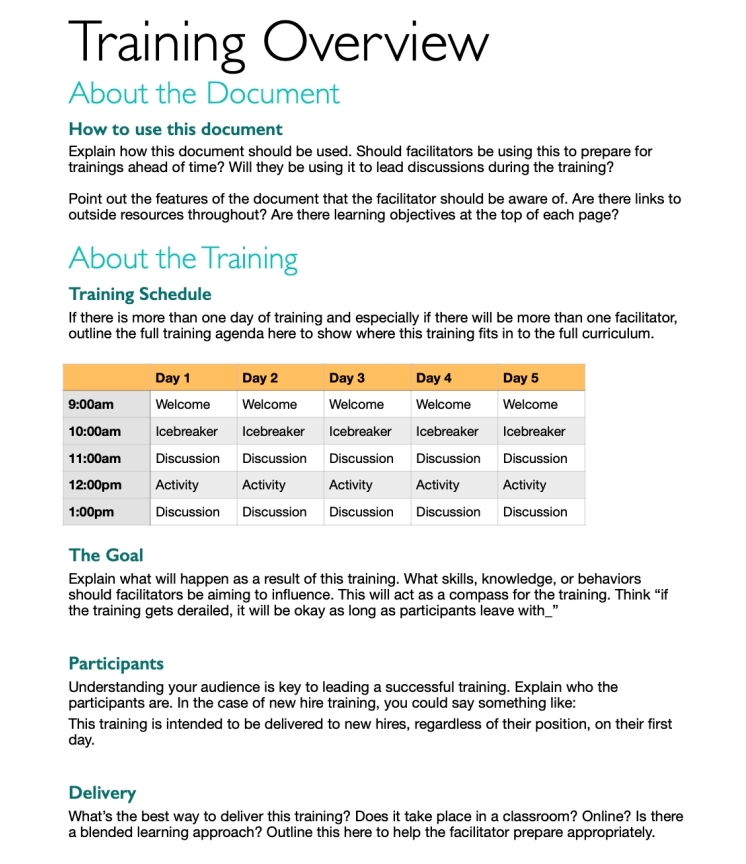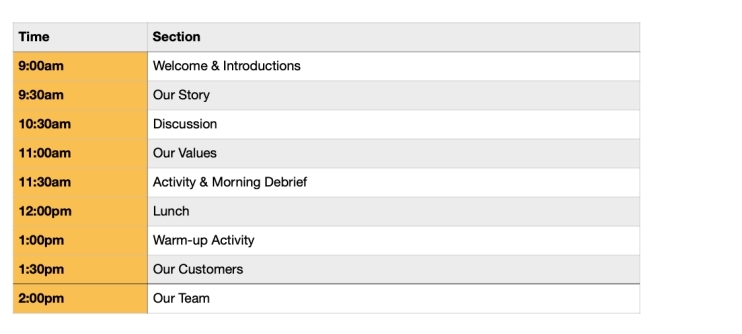How to Create a Facilitator’s Guide to Deliver Better Instructor-Led Training + Examples
WorkRamp Contributor
Learning Tips Straight to Your Inbox
Think back to the best training you’ve ever participated in. Chances are that what you remember most from the session isn’t the content or agenda but rather the training facilitator. The best, most engaging Instructor-Led Training (ILT) sessions are typically led by a personable, well-prepared, and knowledgeable trainer.
But even experienced trainers can benefit from a thorough facilitator guide. In this article, we’ll show you how to create a facilitators guide and the essential components to set your trainers up for success.
In this post:
What makes a good facilitator?
Besides the attributes mentioned above, a good training facilitator should be comfortable speaking to large groups of people. They don’t necessarily need to be a subject matter expert, but they should be an effective communicator and break down complex topics in a way that makes it easy for participants to understand. Effective facilitation also requires active listening skills to ensure workshop attendees can ask questions and stay engaged.
Behind most effective facilitators is a good facilitator guide, which enlightens the trainer on the information, discussion prompts, and activities needed to run an effective training session. In this post, we’ll break down the definition and elements of a facilitator guide, and the necessary steps to prepare instructors for an organized and productive training session.
Read more: What is a Training Facilitator?
What is a facilitator guide?
To understand what should go into a facilitator guide for an ILT, it’s important to define what a facilitator guide is.
A facilitator guide is a resource for trainers to understand the goals of a training session and how they should go about teaching the material. Creating facilitator guides should be one of the last steps in preparing ILT, as you’ll want to ensure your guides outline the learning objectives and schedule.
When executed correctly, a facilitator guide will ensure that all of the learning objectives of an ILT are addressed effectively in the time allotted for the session.
What is the purpose of a facilitator’s guide?
To understand how to write a facilitator guide, it’s important to define what a facilitator guide is.
While you’ll want to spend time training an instructor ahead of an ILT, think of a facilitator guide as something you’d be able to hand off to the trainer on the day of the session, feeling confident that they could use it to conduct the training. It should be structured and as detailed as possible without being too lengthy. The facilitator should be able to use the guide to both prepare for the session and refer to it on the day of.
Your facilitator guide should be descriptive and prescriptive, allowing the facilitator to inject their wisdom, ideas, and personality.
How do I make a facilitator’s guide?
To create an effective facilitator guide for trainers, it’s essential to understand the necessary components.
To streamline the process, you can start with a template like this New Hire Training Facilitator Guide. But whether you’re using a template or creating your own, here are the must-have items to include.
What should a facilitator’s guide include?
Regardless of the training’s subject matter, good facilitator guides have a few things in common.
Elements of a training facilitator guide include:
- Goals of the training session. Be explicit in stating what knowledge, skills, or behaviors the learner should understand by the conclusion of the session.
- Table of contents. In addition to understanding the session’s goals, the table of contents creates a way to organize the guide and help participants navigate the material.
- Overview of what the learners have studied and where the training fits into the larger learning curriculum. This will help the trainer avoid sharing redundant information and prevent them from incorrectly assuming what background information the learners have ahead of the session.
To underscore which training sections are especially important for learners, include timing guidelines to help the trainer stay on task. It is also beneficial to provide a description for each training section to avoid confusion around the purpose of a specific discussion section or activity.
Sample talking points and discussion questions (and even answers to listen for) are especially useful for newer trainers, as long as you are sure to stress that they are there as suggestions. After all, the most engaging sessions are those in which the trainer is personable and animated—not when the trainer is reading from a script.
Supplemental resources and learning materials (such as videos and articles) will allow the trainer to refer learners to more information whenever necessary.
Here’s an example of how to define your training goals and define your objectives.

Preparing the trainer for the session
To set your trainer up for success, you must ensure they are prepared for the session. This will entail preparation sessions and even the occasional “train the trainer” class to ensure that facilitators are up-to-date on best practices.
Whenever possible, it’s best to involve the trainer in session preparation as early as you can. This may even entail having the trainer help build the facilitator training guide—who better than the facilitator to share insight on what should and shouldn’t be included?
When preparing someone new to facilitating, try partnering them with an experienced trainer for a practice session to review the material. You may even want to recruit someone not involved in the training process to share their feedback on a practice session and adjust the facilitator guide accordingly.
Above all, it’s good to get the facilitator in the practice of rehearsing the session ahead of time. You’ll want to ensure that any of their questions about the session’s goals or strategies are resolved well before the actual training.
Use your facilitator’s guide to set yourself (and your trainers) up for success
When selecting trainers for a session, you’ll want to consider a few qualities beyond their professional expertise. A great training facilitator is someone who is naturally empathetic and patient with people in new situations. They should be adaptable and accommodating—willing to look beyond preconceived notions about their learners’ abilities or performance during the training.
These leadership characteristics are more important than the trainers’ subject knowledge. The trainer can always defer technical questions to another expert in the organization.
In addition to setting trainers up for success with each ILT, you’ll want to take steps toward creating a facilitator guide template for yourself.
Spend time designing an editable facilitator guide template that is clean, simple, and easily readable. You should break up content sections with varying colors, an agenda table, and headings that render the template clear and easily scannable.
With each ILT, gather detailed feedback from the trainer on what aspects of the guide need to be clarified or improved—and use that information to make changes to your template. This process will allow you to refine your guides over time, providing better facilitator guides with each new training.
Create your own facilitator guide template
Now that you know how to help your facilitator’s prepare, let’s look at the specific items you should include in your facilitator’s guide. Besides the sample overview you shared above, you’ll also want to include the following items.
Facilitator checklist
Give the facilitator and idea of what he or she will need to prepare ahead of the training so they can plan accordingly.

Agenda
Including an agenda in your facilitator guide helps participants understand how the training will be structured.
Include times that specific events will occur to allow participants to coordinate schedules and manage expectations.

Training objectives
Help participants understand what they can expect from the training. What skills will they learn, and what will they be able to do after completing the training?

To learn more and start creating your facilitator guide template, download this free New Hire Training Facilitator Guide.
Complete the form for a custom demo.
Recent Posts
- Top LMS Integrations That Power Smarter, Faster Learning July 2, 2025
- Introducing WorkRamp Analytics Studio: Unlocking Your Data Insights with AI June 30, 2025
- 11 AI LMS for AI-Powered Learning June 27, 2025
- The Best LMS Platforms for Customer Retention (2025 Guide) June 27, 2025
- 11 Best AI Learning Platforms June 16, 2025
WorkRamp Contributor
You might also like
Driving Employee Performance with Virtual Instructor-Led Trainings
Check out best practices on creating an effective Virtual Instructor-Led Training that your facilitators and learners will love.
Read More
How to Create and Sustain a Flexible Remote Learning Program
Learn what your team needs to successfully train, onboard, and develop learners with a flexible corporate training program using your LMS.
Read More
Handshake’s Playbook on Sales Certifications and Remote Training
Learn how Handshake rolled out a new product messaging framework, overhauled the entire sales motion and fully trained his team on a new virtual selling playbook.
Read More
Ready to Get Started?
Get in touch to learn how WorkRamp can help you achieve your training goals.
Request a Demo





